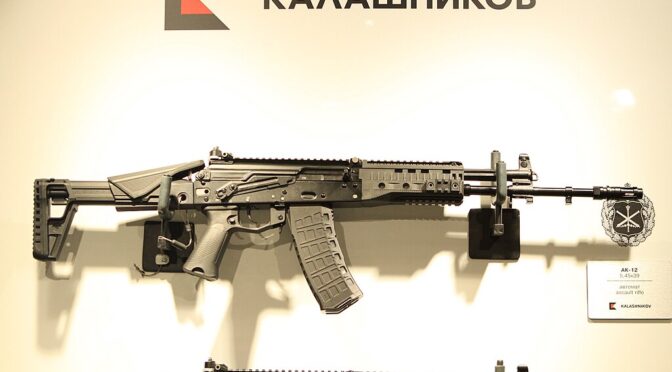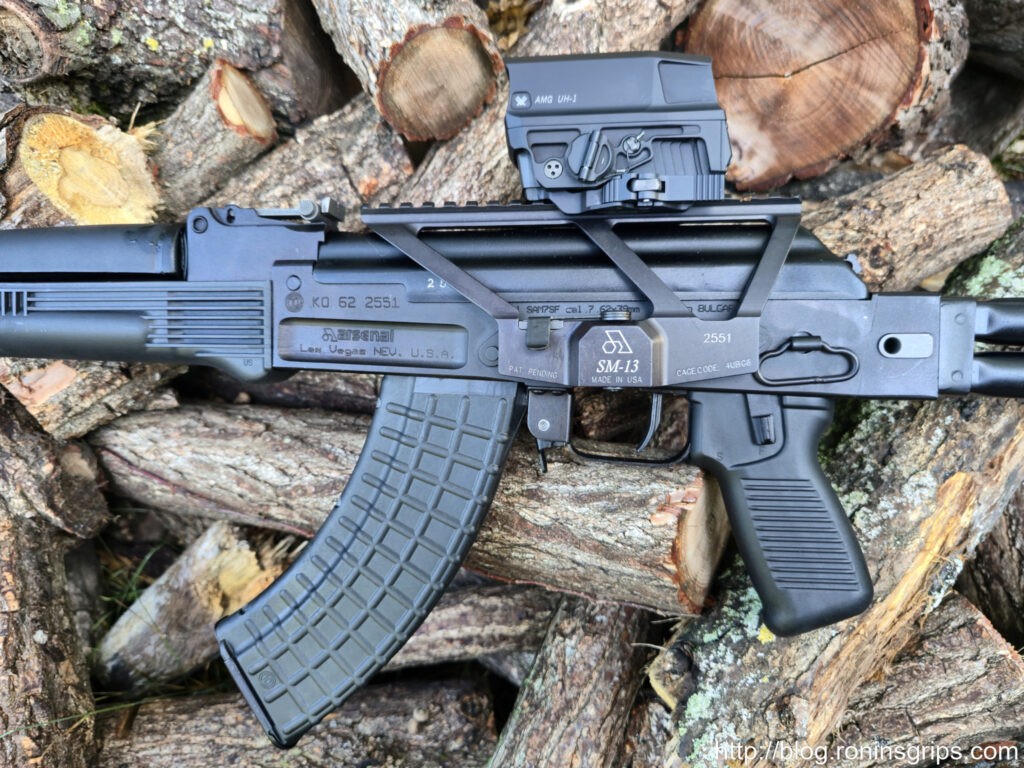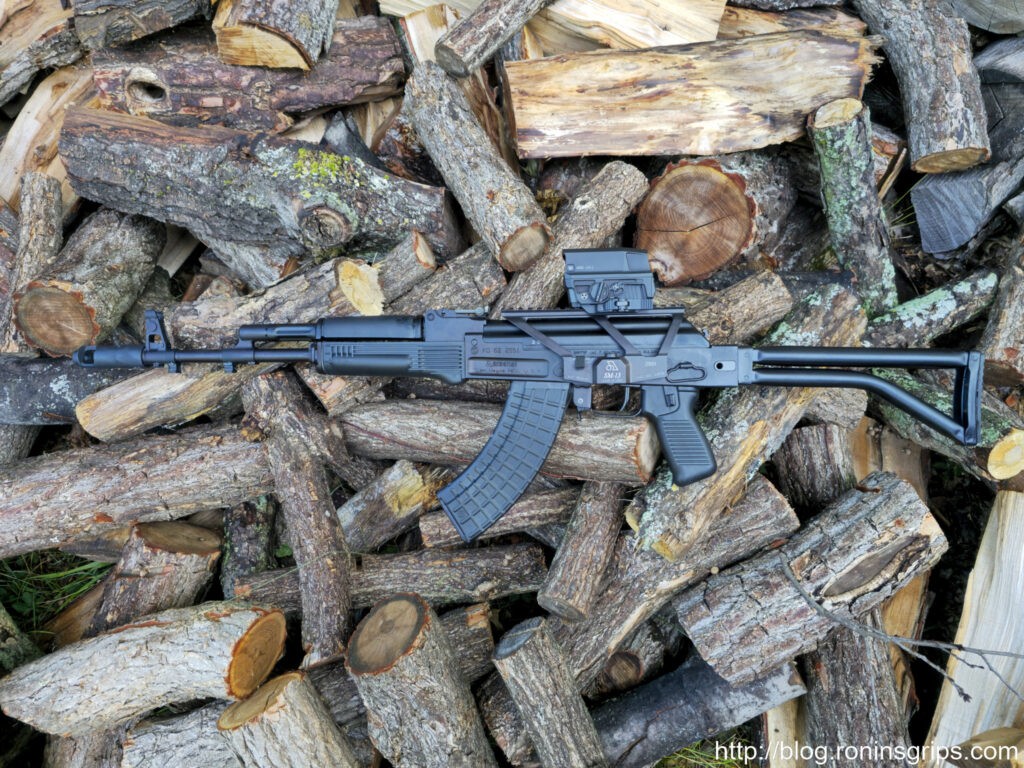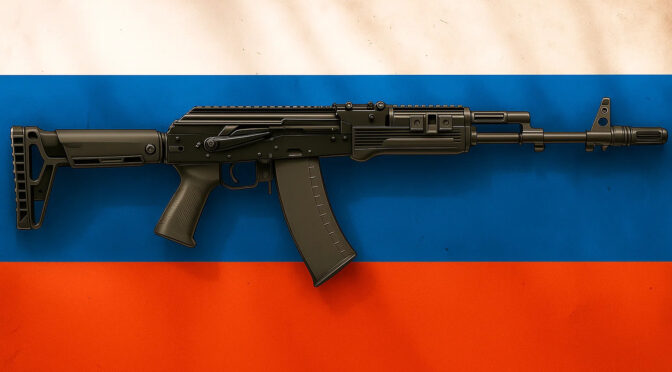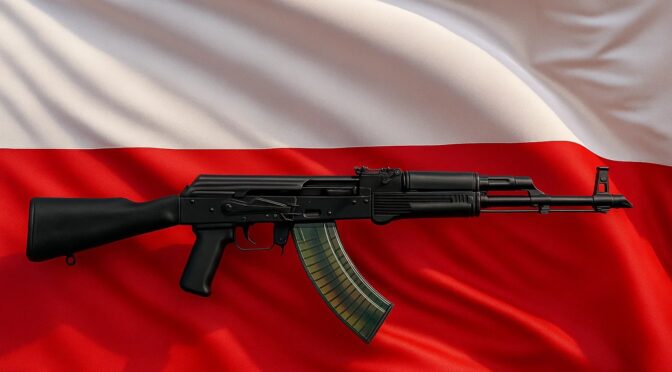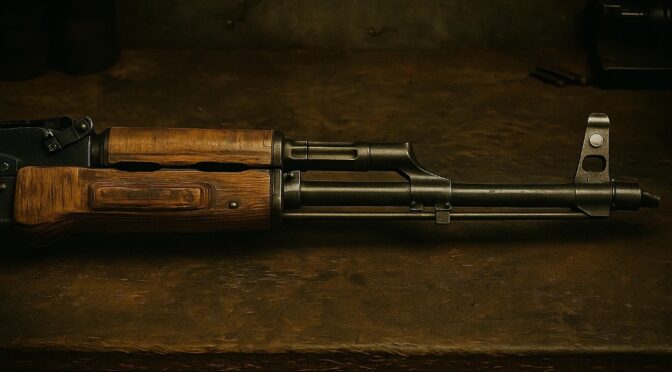The development of the Kalashnikov AK-12 and AK-15 assault rifles cannot be understood in isolation. These weapons were not conceived in a vacuum but were born as a required component of a far broader and more ambitious initiative: the “Ratnik” (Ратник, or “Warrior”) future infantry combat system. This program, initiated in the early 2000s, represented a fundamental doctrinal shift for the Russian Armed Forces, moving away from the Soviet concept of the expendable mass infantryman toward a vision of a highly equipped, protected, and interconnected soldier capable of operating effectively on the 21st-century battlefield.1
The impetus for Ratnik grew from the stark lessons learned during the post-Soviet conflicts of the 1990s and early 2000s, particularly in Chechnya. Russian infantry forces, equipped with largely outdated Soviet-legacy gear, were found to be technologically inferior to their Western counterparts.3 The program’s primary objective was to close this gap by holistically improving the combat effectiveness, connectivity, and survivability of the individual soldier through the integration of dozens of new components.4 Ratnik was conceived as a modular “system of systems,” comprising approximately 10 subsystems and nearly 60 individual items that could be tailored to a soldier’s specific role and mission.4
The core of the Ratnik system is built upon three pillars: protection, command and control, and enhanced lethality. The protection suite is formidable, designed to cover nearly 90% of a soldier’s body.2 The primary component is the 6B45 general-issue body armor, which in its standard configuration weighs 7.5 kg and is rated at GOST R 50744-95 protection class 6. This level of protection is sufficient to defeat multiple close-range impacts from 7.62x39mm rounds and even 7.62x54mmR sniper rifle rounds, including those with hardened steel penetrators.2 This armor is complemented by the 6B47 aramid fiber helmet, protective goggles, and joint protectors, creating an environment where the soldier is significantly more resilient to battlefield threats than ever before.4
The nervous system of the Ratnik ensemble is the “Strelets” (Стрелец, or “Musketeer”) command, control, communications, and intelligence (C3I) system.4 This system provides squad members with voice and video communication, GLONASS satellite navigation, and individual tactical computers. A squad leader is equipped with a small, book-sized computer that displays the real-time location of each soldier, allowing for unprecedented battlefield management.2 This system proved its effectiveness in combat during operations in Syria, where it was used to pass targeting data from ground troops directly to strike aircraft, dramatically shortening the “sensor-to-shooter” cycle.7
This new digital and protected battlefield environment directly informed the requirements for a new service rifle. The primary driver for replacing the venerable AK-74M was not a fundamental flaw in its renowned operating mechanism, but rather its profound inadequacy as a modern weapons platform. The Ratnik program’s emphasis on integrated digital optics (like the 1PN140 thermal and 1PN141 night vision sights), helmet-mounted displays, and laser designators demanded a chassis capable of hosting these components effectively and reliably.3 The standard AK-74M, with its side-mounted “dovetail” rail, is notoriously ill-suited for mounting modern optics, especially in-line “clip-on” thermal or night vision devices which require a stable, zero-retaining platform on the receiver’s top cover. Its handguards were not designed to mount lasers or lights without specialized, often aftermarket, solutions. The rifle had to evolve from a standalone tool into an essential, integrated subsystem within the larger Ratnik combat architecture.
The formal requirement for a new rifle was introduced into the Ratnik trials, which evolved from the earlier “Barmitsa” research program, largely due to lobbying from Russian Special Forces (Spetsnaz) elements.9 These elite units, who often had greater exposure to Western equipment, understood the limitations of the existing Kalashnikovs. A critical demand they placed on the program was for the new weapon system to be available in two calibers: the standard-issue 5.45x39mm and the older 7.62x39mm cartridge. The 7.62mm round remained highly popular within SOF circles for its superior performance in penetrating light cover and, crucially, for the excellent performance of its subsonic variants when used with suppressors.9 This dual-caliber requirement would become a central tenet of the entire development program that followed.
A False Start: The Trials, Tribulations, and Failure of the Zlobin AK-12
Before the Kalashnikov Concern could develop the rifle that would eventually be adopted, it first had to navigate a series of high-profile failures that left it without a viable candidate for the Ratnik trials. The most notable of these preceding efforts was the AK-107, a rifle based on the Balanced Automatics Recoil System (BARS). This complex system, in development since the 1970s, used a counter-mass that moved in opposition to the bolt carrier to mitigate felt recoil and muzzle rise.10 While technically interesting, the BARS rifles proved to be a dead end for military development. The system was complex, expensive, added weight, and, in a critical flaw, was incompatible with the standard GP-25/34 under-barrel grenade launcher. The powerful recoil impulse from firing a 40mm grenade was found to be capable of damaging or completely disabling the delicate counter-balance mechanism.11
With the BARS rifles rejected, the Izhmash factory (which would later become the core of the Kalashnikov Concern) was in a difficult position. In 2011, a significant leadership change brought in Vladimir Zlobin, the former chief designer from the rival Tula arms factory, to lead a new project.10 Under Zlobin, a new rifle was rapidly developed, also designated “AK-12.” This was not an evolution of the existing Kalashnikov but a “clean slate” design that retained only the basic long-stroke gas piston operating principle. It shared less than 10% of its parts with the legacy AK-74M.10
Zlobin’s prototype was ambitious and incorporated a host of features clearly inspired by Western rifle designs, aimed at addressing the ergonomic shortcomings of the classic AK.
- Modernized Ergonomics: The design featured a truly ambidextrous, non-reciprocating charging handle that could be swapped to either the left or right side of the weapon. The traditional, large sheet-metal safety/selector lever was replaced with a smaller, ambidextrous thumb-actuated switch located above the pistol grip, allowing for manipulation without breaking the firing grip.10
- Advanced Architecture: It incorporated a full-length, monolithic MIL-STD-1913 Picatinny rail on a redesigned, hinged top cover for stable optics mounting. The stock was a new telescoping and side-folding design. In a major departure from Kalashnikov tradition, the rifle also featured a last-round bolt hold-open mechanism, which would lock the bolt to the rear on an empty magazine.10
- New Fire Control Group: The selector offered four positions: safe, semi-automatic, a three-round burst mode, and fully automatic fire.14
This radical new design was submitted to the Ratnik trials, where it failed spectacularly.10 The results were, by all accounts, disastrous for Izhmash. The Zlobin AK-12 was plagued by significant reliability and durability issues. Reports from the trials indicated that the rifle was literally breaking under the stress of sustained firing; critical components like the hammer and even the bolt carrier itself were failing.12 In other tests, the rifle failed basic drop tests, with one prototype suffering a bent receiver and another having its charging handle snap off.11
Compounding the reliability problems was the rifle’s prohibitive cost. The complex new components and manufacturing processes resulted in a weapon that was estimated to cost five to six times more than a standard-issue AK-74M.10 For a military that maintained millions of Kalashnikovs in reserve and was focused on mass procurement, this price was untenable. In 2013, the Russian Ministry of Defence (MoD) officially rejected the Zlobin AK-12, stating that it did not meet state requirements and would need significant, time-consuming, and expensive redevelopment to rectify its many flaws.10
The Zlobin prototype ultimately failed because it violated the core tenets of the very design philosophy it sought to inherit. The Kalashnikov platform’s global success is built on a foundation of radical simplicity, loose tolerances, and “good enough” reliability that ensures function under the worst possible conditions. Zlobin’s design attempted to graft complex, Western-style features requiring tighter tolerances and more intricate parts onto this foundation. The reported failures suggest the design was simply not robust enough to handle the violent action of the long-stroke piston system, or that the manufacturing and materials science were not prepared to produce these more complex components reliably and cost-effectively. The MoD, faced with a choice between a proven, cheap, reliable-if-unmodern AK-74M and an expensive, unreliable, complex new rifle, defaulted to their deep-seated institutional preference for proven, economical technology. The Zlobin AK-12 offered theoretical ergonomic advantages but failed the fundamental test of being a durable, affordable tool of war.
A Pragmatic Reset: The AK-400 and the Birth of the Production AK-12/15
Following the public and costly failure of the Zlobin prototype, another leadership change took place as Izhmash was reorganized into the new state-owned Kalashnikov Concern. Sergey Urzhumtsev was appointed as the new chief designer, and he immediately abandoned the “clean slate” approach.10 The new philosophy was one of pragmatic evolution, not revolution. A new program, internally designated “AK-400,” was launched with the goal of retaining the proven, reliable, and inexpensive-to-produce core of the AK-74M while systematically addressing its key shortcomings for modern combat.10 This approach maximized parts commonality with the legacy rifle (over 50%, compared to the Zlobin prototype’s less than 10%), which allowed the use of existing tooling and manufacturing lines, dramatically reducing development time and unit cost.10
The AK-400 program, which would become the basis for the production AK-12, focused on three critical engineering problems: unstable optics mounting, mediocre accuracy, and poor ergonomics.
The most important innovation was the solution to the optics problem. The flimsy, stamped-steel dust cover of previous AKs was replaced with a redesigned, more rigid top cover. This new cover is hinged at the front trunnion (where the barrel is seated) and is secured at the rear by a captive cross-pin and a spring-loaded latch system. This design effectively eliminates the “wobble” that plagued previous attempts to mount optics on an AK’s cover, creating a stable, zero-retaining MIL-STD-1913 Picatinny rail along the top of the weapon.9 This single change was the key enabler for the rifle’s integration into the Ratnik system, finally allowing for the reliable mounting of heavier optics like night vision and thermal sights in-line with a primary day optic.
To improve accuracy, the production AK-12 introduced a “free-floating” barrel. In a traditional AK, the handguard makes contact with the barrel, meaning that pressure on the handguard (from a bipod, a sling, or the soldier’s grip) can induce stress on the barrel, negatively affecting its natural harmonics and shifting the bullet’s point of impact. In the new design, the handguard is rigidly attached to the receiver at the rear and to a more robust, permanently affixed gas tube at the front, never touching the barrel itself.9 This allows the barrel to vibrate more consistently from shot to shot, leading to a measurable improvement in precision. The iron sights were also modernized, replacing the traditional rear leaf sight with an aperture (diopter) sight, which was moved to the rearmost position on the new top cover. This significantly lengthened the sight radius, further contributing to improved practical accuracy.9
Finally, the rifle’s ergonomics were brought into the 21st century. A new, side-folding polymer buttstock, conceptually similar to that of the American M4 carbine, was made standard. It is adjustable for length of pull, allowing it to be adapted to soldiers of different sizes and to those wearing bulky body armor.18 The classic Kalashnikov safety lever, often criticized for its awkward operation, was retained for its simplicity and function as a dust cover. However, it was modified with the addition of a small shelf, or “finger pedal,” which allows the user to actuate the safety with their trigger finger without completely removing their hand from the pistol grip.9 As per the original Ratnik requirements, a two-round burst fire mode was also incorporated into the fire control group.9
The AK-400-derived rifles—now officially designated the AK-12 (GRAU index 6P70) in 5.45x39mm and the AK-15 (GRAU index 6P71) in 7.62x39mm—were submitted for a new round of state trials. This time, the results were positive. The rifles were found to be more accurate and approximately 0.5 kg lighter than an AK-74M with a full modernization kit, while being vastly cheaper and more reliable than both the Zlobin prototype and the competing balanced-action A-545 rifle.9 In early 2018, the Russian MoD officially recommended the AK-12 and AK-15 for general adoption by infantry, airborne, and naval infantry troops. The more complex and expensive A-545 was relegated to limited use by special forces units who could theoretically benefit from its recoil mitigation system.9
The success of the production AK-12 was a victory for industrial pragmatism over pure design ambition. The Urzhumtsev team correctly identified that the core action of the Kalashnikov was not the problem; it was reliable, robust, and cheap to make. The problem was the user interface—everything the soldier touched and looked through. Their solutions were all external to the core mechanism. This makes the production AK-12 not a true “5th generation” rifle, but rather a “4.5th generation” weapon: a highly evolved AK-74M chassis that successfully bridges the gap between a 1970s design and the demands of an optics-driven, modular 21st-century battlefield.
Trial by Fire: Combat Feedback and the Iterative Evolution of the AK-12
Despite passing state trials and being officially adopted in 2018, the initial production model of the AK-12 (often referred to as the 2016 model) soon revealed numerous design flaws and quality control issues once it was issued in large numbers. Direct and often harsh feedback from troops, particularly from elite VDV (airborne) units and soldiers engaged in the full-scale invasion of Ukraine starting in 2022, drove a rapid and significant iterative development cycle.16
The most common criticisms of the initial production model focused on ergonomics, durability, and questionable features.
- Controls and Ergonomics: The four-position fire selector (Safe-Auto-Burst-Semi) was widely criticized as being inconvenient and poorly designed. The “finger pedal,” intended to improve ergonomics, was reportedly so stiff from the factory that it could not be operated with the index finger alone, defeating its purpose. Furthermore, when set to semi-automatic, the large lever could partially obstruct the trigger finger, especially for users with large hands or wearing gloves.21
- Furniture Durability: The new lightweight, adjustable stock proved to be fragile. There were numerous reports of the stock’s locking mechanism breaking under the stress of combat or even during routine handling.21 The polymer handguard was also found to be brittle, with VDV troops complaining that it would crack or break during parachute jumps. It was also prone to developing “wobble,” which would compromise the zero of any laser aiming devices mounted to it.22
- Unnecessary Complexity: The two-round burst mode, a feature mandated by the original Ratnik requirements, was almost universally seen by soldiers as tactically useless. It added unnecessary complexity to the fire control group and was an additional mode to cycle through when trying to select semi-automatic fire under stress.22
- Maintenance and Optics: The gas block was reportedly difficult to access and clean properly, a major liability given the Russian military’s standard use of corrosive-primed ammunition.24 While the railed top cover was a significant improvement, some users still reported issues with it holding zero over time, questioning the long-term durability of the riveted construction.21
In 2020, Kalashnikov Concern introduced a minor update to address some of the initial ergonomic complaints. This version featured a new, lighter-weight adjustable stock design and a revised, more comfortable pistol grip.26 However, this was merely a stopgap. The intense combat experience in Ukraine provided a flood of unfiltered data that prompted a much more significant overhaul.
The AK-12 (2023 Model) was officially unveiled in May 2023, incorporating a host of changes based directly on combat feedback.17
- Simplified and Ambidextrous Controls: The problematic four-position selector and the two-round burst mode were completely eliminated. The new design features a simple two-position selector (Safe/Fire) that retains the traditional right-side lever but adds a small, independent thumb-operated lever on the left side of the receiver. This finally provides true ambidextrous fire control.23
- New Muzzle Device: The original quick-detach muzzle brake was replaced by a non-removable, birdcage-style flash hider. This new device is designed to serve as a standard mounting interface for a new quick-detach suppressor. This change simplifies the system and ensures compatibility with standard-issue equipment, reportedly to prevent soldiers from using non-standard or captured suppressors.17
- Reinforced Furniture and Sights: The handguard was redesigned and reinforced to improve durability and better resist overheating during sustained fire.17 The stock was updated again, now incorporating an adjustable cheek riser to provide a proper cheek weld when using optics of varying heights.23 A new, more robust diopter rear sight was introduced, and the fastening mechanism for the top cover was strengthened to improve zero retention.23
The evolution from the 2016 model to the 2023 model is a clear demonstration of a design cycle being driven by battlefield pragmatism. Features that looked good during peacetime trials, like the two-round burst, were stripped away in favor of robust simplicity. The 2023 model is, in many ways, less “advanced” than its predecessor, but it is a far more mature and soldier-focused weapon. It represents the brutal but necessary process of refining a design based on the realities of peer-level conflict, where durability and ease of use are paramount.
| Feature | Zlobin Prototype (2012) | Production Model (2016) | Combat Update (2023) |
| Operating System | Long-Stroke Gas Piston | Long-Stroke Gas Piston | Long-Stroke Gas Piston |
| Receiver Cover | Hinged, Monolithic Rail | Hinged, Rigid Rail, Pin/Latch Lock | Hinged, Rigid Rail, Strengthened Lock |
| Fire Selector | Ambidextrous Thumb Selector | Right-Side Lever w/ Finger Pedal | Ambidextrous (Right Lever + Left Thumb) |
| Burst Mode | 3-Round Burst | 2-Round Burst | Eliminated |
| Stock | Telescoping/Folding | Telescoping/Folding (Fragile) | Telescoping/Folding w/ Cheek Riser |
| Handguard | Railed, Polymer | Free-Float, Railed (Brittle) | Free-Float, Reinforced, Railed |
| Muzzle Device | NATO-Standard Brake | Proprietary QD Muzzle Brake | Non-Removable Flash Hider/Suppressor Mount |
| Sights | Rear Leaf | Rear Diopter | Improved Rear Diopter |
| Parts Commonality | <10% (with AK-74M) | ~54% (with AK-74M) | ~54% (with AK-74M) |
The Kalashnikov 6P70 Family: Variants and Specifications
The core design of the production AK-12, born from the AK-400 program, has served as the foundation for a full family of small arms. This family is designed to meet a variety of tactical requirements for both the Russian military and the international export market. The primary variants share the same fundamental engineering principles—the free-float barrel, rigid railed top cover, and improved ergonomics—while being adapted for different calibers and barrel lengths.
- AK-12 (GRAU 6P70): The standard-issue assault rifle for the Russian Armed Forces, chambered in the 5.45x39mm intermediate cartridge.17
- AK-15 (GRAU 6P71): The 7.62x39mm counterpart to the AK-12. It was developed concurrently to meet the specific requirements of Russian Special Forces, who value the cartridge’s effectiveness against light barriers and its compatibility with subsonic ammunition for suppressed operations.9
- AK-12K & AK-15K: These are the compact carbine versions of the standard rifles, featuring significantly shorter barrels (290 mm vs. 415 mm). They are intended for use in close-quarters battle (CQB) by special forces or as personal defense weapons (PDWs) for vehicle crews and operators of heavy weapons. Due to their shortened length, they do not have a bayonet lug and cannot mount an under-barrel grenade launcher.9
- AK-19: An export-focused variant based on the updated AK-12 (2020/2023) platform but chambered for the 5.56x45mm NATO cartridge. It features the birdcage-style flash hider with integral suppressor compatibility, making it attractive to foreign clients who have standardized on NATO ammunition.17
- AK-308: A battle rifle variant chambered in the full-power 7.62x51mm NATO cartridge. Based on the reinforced receiver of the AK-15, it is designed for the export market for nations seeking a more powerful designated marksman or general-purpose rifle.30
The following table provides a comparative overview of the key specifications for the primary variants adopted by the Russian military.
| Specification | AK-12 (6P70) | AK-15 (6P71) | AK-12K | AK-15K |
| GRAU Index | 6P70 | 6P71 | N/A | N/A |
| Caliber | 5.45x39mm | 7.62x39mm | 5.45x39mm | 7.62x39mm |
| Action | Gas-operated, long-stroke piston | Gas-operated, long-stroke piston | Gas-operated, long-stroke piston | Gas-operated, long-stroke piston |
| Weight (empty) | 3.5 kg – 3.7 kg | 3.5 kg – 3.75 kg | 3.4 kg | 3.4 kg |
| Barrel Length | 415 mm | 415 mm | 290 mm | 290 mm |
| Overall Length (extended) | 880 – 940 mm | 880 – 940 mm | 810 mm | 810 mm |
| Overall Length (folded) | 690 mm | 690 mm | 570 mm | 570 mm |
| Magazine Capacity | 30 rounds (standard) | 30 rounds (standard) | 30 rounds (standard) | 30 rounds (standard) |
| Rate of Fire (cyclic) | ~700 rpm | ~700 rpm | ~700 rpm | ~700 rpm |
| Muzzle Velocity | ~900 m/s | ~715 m/s | N/A | N/A |
| Point-Blank Range | 440 m | 350 m | N/A | N/A |
Conclusion: An Evolutionary Compromise in Steel
The story of the AK-12 and AK-15 is one of tumultuous development, battlefield adaptation, and ultimately, pragmatic compromise. The rifle’s journey—from the ambitious but fatally flawed Zlobin prototype to the practical but imperfect 2016 production model, and finally to the battle-hardened 2023 iteration—mirrors the broader tensions within the modern Russian defense industry as it struggles to reconcile a legacy of Soviet-era industrial philosophy with the demands of 21st-century warfare.
The final, adopted AK-12 is not the revolutionary leap forward that was initially envisioned. It is a carefully calculated evolution. The program’s success lies in its abandonment of ambition in favor of realism. Instead of redesigning the weapon from the ground up, the Kalashnikov Concern leveraged its vast industrial base built around the simple, proven Kalashnikov action and focused on solving the critical user-interface problems of its predecessor.10 By adding a stable optics rail, a free-floating barrel, and modern, adjustable furniture, it created a platform that could finally serve as an effective subsystem within the integrated Ratnik combat ensemble.
In this, the AK-12/15 program was a success. It delivered a rifle that is demonstrably more accurate, more ergonomic, and vastly more modular than the AK-74M it replaces, and it did so in a cost-effective manner suitable for mass production. However, the path from design to a truly mature weapon system was painful and fraught with challenges. The initial quality control issues and the litany of flaws identified in the 2016 model revealed a disconnect between design requirements and the realities of military use. It took the brutal, unfiltered feedback from a major war to force the necessary simplifications and improvements that led to the far more robust 2023 model.21
The AK-12, therefore, stands as a testament to an evolutionary compromise. It is a rifle that successfully bolts modern necessities onto a 75-year-old core design. It remains, fundamentally, a Kalashnikov: a simple, reliable, and economical tool of war that has been pragmatically, and at times arduously, adapted to remain relevant in a new century of conflict.
Photo Source
The main blog photo from the Army 2023 show from Wikipedia and was downloaded October 8, 2025. The photo was taken by Nickel Nitride and placed in the Public Domain.
If you find this post useful, please share the link on Facebook, with your friends, etc. Your support is much appreciated and if you have any feedback, please email me at in**@*********ps.com. Please note that for links to other websites, we are only paid if there is an affiliate program such as Avantlink, Impact, Amazon and eBay and only if you purchase something. If you’d like to directly contribute towards our continued reporting, please visit our funding page.
Sources Used
- Unveiling the Legend: Ratnik Russia’s Stealthy Military past – Digital Credentials, accessed August 2, 2025, https://certificates.acn.edu.au/ratnik-russia
- ‘Ratnik’ system improving the battle space situation awareness, connectivity, survivability and combat effectiveness of Russian Army – International Defense Security & Technology, accessed August 2, 2025, https://idstch.com/military/army/ratnik-system-improving-battle-space-situation-awareness-connectivity-survivability-combat-effectiveness-russian-army/
- Putins infantry soldier of the future – SPARTANAT.com, accessed August 2, 2025, https://spartanat.com/en/putins-infantrist-der-zukunft
- Ratnik (program) – Wikipedia, accessed August 2, 2025, https://en.wikipedia.org/wiki/Ratnik_(program)
- Russian Ratnik Infantry Equipment System – Military.com, accessed August 2, 2025, https://www.military.com/video/logistics-and-supplies/uniforms/russian-ratnik-infantry-equipment-system/4722024906001
- Ratnik: Russia’s Modern Warrior Program – Grey Dynamics, accessed August 2, 2025, https://greydynamics.com/ratnik-russias-modern-warrior-program/
- Russia’s Ratnik soldier system – Global Defence Technology | Issue 130 | December 2021, accessed August 2, 2025, https://defence.nridigital.com/global_defence_technology_dec21/ratnik_soldier_system
- GEAR GUIDE: The Russian Ratnik System – SPARTANAT.com, accessed August 2, 2025, https://spartanat.com/en/gear-guide-das-russische-ratnik-system
- AK-12 & AK-15 5th Generation Kalashnikov: Rifles for the 21st Century Russian Military, accessed August 2, 2025, https://sadefensejournal.com/ak-12-ak-15-5th-generation-kalashnikov-rifles-for-the-21st-century-russian-military/
- The Strange Story of the AK-12 Rifle – The National Interest, accessed August 2, 2025, https://nationalinterest.org/blog/buzz/strange-story-ak-12-rifle-32852
- AK-12: Or as Close as We Can Get to the Real Thing… [REVIEW] – Recoil Magazine, accessed August 2, 2025, https://www.recoilweb.com/ak-12-review-184542.html
- Zlobin AK-11 the first prototype AK-12 made for Ratnik program after the AK-107 fail to meet one of the requirement, it was made in a short amount of time to made up for the AK-107 and end up failing even worse : r/ForgottenWeapons – Reddit, accessed August 2, 2025, https://www.reddit.com/r/ForgottenWeapons/comments/qrt1g2/zlobin_ak11_the_first_prototype_ak12_made_for/
- AK-12—Meeting the Russian Warfighter’s Needs – Small Arms Defense Journal, accessed August 2, 2025, https://sadefensejournal.com/ak-12-meeting-the-russian-warfighters-needs/
- AK-12 Assault Rifle- Kalashnikova 2012 Автомат Калашникова образца 2012 года, accessed August 2, 2025, https://www.shootersreport.com/rifle/History-and-Development-of-AK-12-Assault-Rifle.htm
- Engineering:AK-12 – HandWiki, accessed August 2, 2025, https://handwiki.org/wiki/Engineering:AK-12
- MILITARY: Kalashnikov AK-12 infographic – Graphic News, accessed August 2, 2025, https://www.graphicnews.com/en/pages/43250/military-kalashnikov-ak-12
- AK-12 – Wikipedia, accessed August 2, 2025, https://en.wikipedia.org/wiki/AK-12
- AK-12 – Kalashnikov Group, accessed August 2, 2025, https://en.kalashnikovgroup.ru/catalog/boevoe-strelkovoe-oruzhie/avtomaty/avtomat-kalashnikova-ak-12
- AK-15 || Kalashnikov Group, accessed August 2, 2025, https://en.kalashnikovgroup.ru/catalog/boevoe-strelkovoe-oruzhie/avtomaty/avtomat-kalashnikova-ak-15
- Kalashnikov AK-12 and AK-15 assault rifles officially approved by Russian MoD, accessed August 2, 2025, https://en.kalashnikovgroup.ru/media/ak-12/ak-12-i-ak-15-prinyaty-na-vooruzhenie-minoborony-rossii
- What did the designers optimize the Russian Ak-12 service rifle to do? What does it do better than the Ak-74? – Quora, accessed August 2, 2025, https://www.quora.com/What-did-the-designers-optimize-the-Russian-Ak-12-service-rifle-to-do-What-does-it-do-better-than-the-Ak-74
- Why does everyone hate the AK-12? – Quora, accessed August 2, 2025, https://www.quora.com/Why-does-everyone-hate-the-AK-12
- Kalashnikov Unveils 2023 Edition of AK-12 || Kalashnikov Media, accessed August 2, 2025, https://en.kalashnikovgroup.ru/media/ak-12/kalashnikov-predstavil-ak-12-obraztsa-2023-goda
- Why we haven’t seen any AK12 since April 2022. : r/NonCredibleDefense – Reddit, accessed August 2, 2025, https://www.reddit.com/r/NonCredibleDefense/comments/16k9v0j/why_we_havent_seen_any_ak12_since_april_2022/
- How superior are the recent Russian Assault Rifles compared to the AK47 and AK74 models they’ve been replacing, particularly the AK15 and AK12? – Reddit, accessed August 2, 2025, https://www.reddit.com/r/WarCollege/comments/wljyy6/how_superior_are_the_recent_russian_assault/
- Kalashnikov presented an updated АК-12, accessed August 2, 2025, https://en.kalashnikovgroup.ru/media/boevoe-strelkovoe-oruzhie/ak-12-2020
- Greed Takes Over Reason in the New AK-12 of the 2023 Edition – Defense Express, accessed August 2, 2025, https://en.defence-ua.com/industries/greed_takes_over_reason_in_the_new_ak_12_of_the_2023_edition-6862.html
- Калашников» представил АК-12 образца 2023 года, accessed August 2, 2025, https://kalashnikovgroup.ru/media/ak-12/kalashnikov-predstavil-ak-12-obraztsa-2023-goda
- GunBusters: Model 2023 AK-12 || Kalashnikov Media, accessed August 2, 2025, https://en.kalashnikovgroup.ru/media/razrushiteli-oruzhiya/razrushiteli-oruzhiya-ak-12-2023-goda
- AK-15: The Russian Assault Rifle That Traces Its Origins Back to the AK-47, accessed August 2, 2025, https://www.warhistoryonline.com/guns/ak-15.html
- AK-12K || Группа компаний «Калашников» – Kalashnikov Concern, accessed August 2, 2025, https://en.kalashnikovgroup.ru/catalog/boevoe-strelkovoe-oruzhie/avtomaty/avtomat-kalashnikova-ak-12k
- Kalashnikov to Debut Latest Short and Compact AK-15 Rifles at IDEX 2025, accessed August 2, 2025, https://en.kalashnikovgroup.ru/news/kalashnikov-to-debut-latest-short-and-compact-ak-15-rifles-at-idex-2025
- AK-15K || Kalashnikov Group, accessed August 2, 2025, https://en.kalashnikovgroup.ru/catalog/boevoe-strelkovoe-oruzhie/avtomaty/avtomat-kalashnikova-ak-15k
- AK-19 – Wikipedia, accessed August 2, 2025, https://en.wikipedia.org/wiki/AK-19
- en.kalashnikovgroup.ru, accessed August 2, 2025, https://en.kalashnikovgroup.ru/media/ttkh-2019/ak-15-ttkh
- АК-15: ТТХ – Концерн «Калашников, accessed August 2, 2025, https://kalashnikovgroup.ru/media/ttkh-2019/ak-15-ttkh
- The AK of Tomorrow: Innovations on a 1947 Design – Small Arms Review, accessed August 2, 2025, https://smallarmsreview.com/the-ak-of-tomorrow-innovations-on-a-1947-design/
